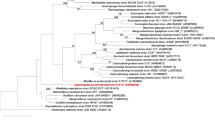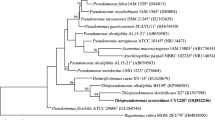Abstract
A new strain of syntrophically propionate-oxidizing fermenting bacteria, strain KoProp1, was isolated from anoxic sludge of a municipal sewage plant. It oxidized propionate or lactate in cooperation with the hydrogen- and formate-utilizingMethanospirillum hungatei and grew as well in pure culture without a syntrophic partner with propionate or lactate plus sulfate as energy source. In all cases, the substrates were oxidized stoichiometrically to acetate and CO2, with concomitant formation of methane or sulfide. Cells formed gas vesicles in the late growth phase and contained cytochromesb andc, a menaquinone-7, and desulforubidin, but no desulfoviridin. Enzyme measurements in cell-free extracts indicated that propionate was oxidized through the methylmalonyl CoA pathway. Protein pattern analysis by SDS-PAGE of cell-free extracts showed that strain KoProp1 differs significantly fromSyntrophobacter wolinii and from the propionate-oxidizing sulfate reducerDesulfobulbus propionicus. 16S rRNA sequence analysis revealed a significant resemblance toS. wolinii allowing the assignment of strain KoProp1 to the genusSyntrophobacter as a new species,S. pfennigii.
Similar content being viewed by others

References
Bartholomew JW (1962) Variables influencing results and the precise definition of steps in gram staining as a means of standadizing the results obtained. Stain Technol 37:139–155
Bergmeyer HU (1974) Methoden der enzymatischen Analyse, 3rd edn. Verlag Chemie, Weinheim Germany
Boone DR, Bryant MP (1980) Propionate-degrading bacterium,Syntrophobacter wolinii sp. nov. gen. nov., from methanogenic ecosystems. Appl Environ Microbiol 40:626–632
Boonstra J, Huttunen MT, Konings WN (1975) Anaerobic transport inEscherichia coli membrane vesicles. J Biol Chem 250: 6792–6798
Bradford MM (1976) A rapid and sensitive method for the quantitation of microgram quantities of protein utilizing the principle of protein-dye binding. Anal Biochem 72:248–254
Cashion P, Holder-Franklin MA, McCully J, Franklin M (1977) A rapid method for the base ratio determination of bacterial DNA. Anal Biochem 81:461–466
Cline JD (1969) Spectrophotometric determination of hydrogen sulfide in natural waters. Limnol Oceanogr 14:454–458
Collins MD (1985) Isoprenoid quinone analyses in bacterial classification and identification. In: Goodfellow M, Minnikin DE (eds) Chemical methods in bacterial systematics. Academic Press, London, pp 267–287
Diekert GB, Thauer RK (1978) Carbon monoxide oxidation byClostridium thermoaceticum. J Bacteriol 136:597–606
Dong X, Plugge CM, Stams AJM (1994) Anaerobic degradation of propionate by a mesophilic acetogenic bacterium in coculture and triculture with different methanogens. Appl Environ Microbiol 60:2834–2838
Dörner C (1992) Biochemie und Energetik der Wasserstofffreisetzung in der syntrophen Vergärung von Fettsäuren und Benzoat. Thesis, Universität Tübingen, Germany
Harmsen HJM, Wullings B, Akkermans ADL, Ludwig W, Stams AJM (1993) Phylogenetic analysis ofSyntrophobacter wolinii reveals a relationship with sulfate-reducing bacteria. Arch Microbiol 160:238–240
Harmsen HJM, Kengen HMP, Akkermans ADL, Stams AJM (1995) Phylogenetic analysis of two syntrophic propionate-oxidizing bacteria in enrichment cultures. Syst Appl Microbiol 18:67–73
Houwen FP, Dijkema C, Schoenmakers CHH, Stams AJM, Zehnder AJB (1987) 13C-NMR study of propionate degradation by a methanogenic coculture. FEMS Microbiol Lett 41:269–274
Houwen FP, Plokker J, Stams AJM, Zehnder AJB (1990) Enzymatic evidence for involvement of the methylmalonyl-CoA pathway in propionate oxidation bySyntrophobacter wolinii. Arch Microbiol 155:52–55
Kroppenstedt RM (1985) Fatty acid and menaquinone analysis of actinomycetes and related organisms. In: Goodfellow M, Minnikin DE (eds) Chemical methods in bacterial systematics. Academic Press, London, pp 173–199
Lee JP, Yi CS, LeGall J, Peck HD (1973) Isolation of a new pigment, desulforubidin, fromDesulfovibrio desulfuricans (Norway strain) and its role in sulfite reduction. J Bacteriol 115:453–455
Matthies C, Schink B (1992) Reciprocal isomerization of butyrate and isobutyrate by the strictly anaerobic bacterium strain WoG13, and methanogenic isobutyrate degradation by a defined triculture. Appl Environ Microbiol 58:1435–1438
Mesbah M, Premachandran U, Whitman W (1989) Precise measurement of the G+C content of deoxyribonucleic acid by high performance liquid chromatography. Int J Syst Bacteriol 39: 159–167
Oberlies G, Fuchs G, Thauer RK (1980) Acetate thiokinase and the assimilation of acetate inMethanobacterium thermoautotrophicum. Arch Microbiol 128:248–252
Odom JM, Peck HD (1981) Localization of dehydrogenases, reductases, and electron transfer components in the sulfate-reducing bacteriumDesulfovibrio gigas. J Bacteriol 147:161–169
Pfennig N (1978)Rhodocyclus purpureus gen. nov. sp. nov., a ring-shaped, vitamin B12-requiring member of the family Rhodospirillaceae. Int J Syst Bacteriol 28:283–288
Platen H, Schink B (1987) Methanogenic degradation of acetone by an enrichment culture. Arch Microbiol 149:136–141
Plugge CM, Dijkema C, Stams AJM (1993) Acetyl-CoA cleavage pathway in a syntrophic propionate-oxidizing bacterium growing on fumarate in the absence of methanogens. FEMS Microbiol Lett 110:71–76
Samain E, Dubourgier HC, Albagnac G (1984) Isolation and characterization ofDesulfobulbus elongatus sp. nov. from a mesophilic industrial digester. Syst Appl Microbiol 5:391–401
Sambrook J, Fritsch EF, Maniatis T (1989) Molecular cloning, a laboratory manual, 2nd edn, vol III. Cold Spring Harbor Laboratory Press, Cold Spring Harbor, New York, pp 18.47–18.59
Schink B (1985) Mechanisms and kinetics of succinate and propionate degradation in anoxic sediments and sewag sludge. J Gen Microbiol 131:643–650
Schink B (1990) Conservation of small amounts of energy in fermenting bacteria. In: Finn RK, Präve P (eds) Biotechnology, vol 2. Hanser Publishers, Munich, pp 63–89
Schink B (1992) Syntrophism among procaryotes. In: Balows A, Trüper HG, Dworkin M, Harder W, Schleifer KH (eds) The prokaryotes, 2nd edn, vol I. Springer, Berlin Heidelberg New York, pp 276–299
Schink B, Friedrich M (1994) Energetics of syntrophic fatty acid oxidation. FEMS Microbiol Rev 15:85–94
Stams AJM, Kremer DR, Nicolay K, Weenk GH, Hansen TA (1984) Pathway of propionate formation inDesulfobulbus propionicus. Arch Microbiol 139:167–173
Stams AJM, Grolle KCF, Frijters CTMJ, van Lier JB (1992) Enrichment of thermophilic propionate-oxidizing bacteria in syntrophy withMethanobacterium thermoautotrophicum orMethanobacterium thermoformicicum. Appl Environ Microbiol 58:346–352
Stams AJM, Van Dijk J, Dijkema C, Plugge CM (1993) Growth of syntrophic propionate-oxidizing bacteria with fumarate in the absence of methanogenic bacteria. Appl Environ Microbiol 59:1114–1119
Tamaoka J, Komagata K (1984) Determination of DNA base composition by reversed-phase high-performance liquid chromatography. FEMS Microbiol Lett 25:125–128
Thauer RK, Jungermann K, Decker K (1977) Energy conservation in chemotrophic anaerobic bacteria. Bacteriol Rev 41:100–180
Tholozan JL, Samain E, Grivet JP, Moletta R, Dubourgier HC, Albagnac G (1988) Reductive carboxylation of propionate to butyrate in methanogenic ecosystems. Appl Environ Microbiol 54:441–445
Tschech A, Pfennig N (1984) Growth yield increase linked to caffeate reduction inAcetobacterium woodii. Arch Microbiol 137:163–167
Wallrabenstein C, Hauschild E, Schink B (1994) Pure culture and cytological properties ofSyntrophobacter wolinii. FEMS Microbiol Lett 123:249–254
Wallrabenstein C, Gorny N, Springer N, Ludwig W, Schink B (1995) Pure culture ofSyntrophus buswellii, definition of its phylogenetic status, and description ofSyntrophus gentianae sp. nov. Syst Appl Microbiol 18:62–66
Widdel F, Pfennig N (1981) Studies on dissimilatory sulfate-reducing bacteria that decompose fatty acids. I. Isolation of a new sulfate reducer enriched with acetate from saline environments. Description ofDesulfobacter postgatei gen. nov. sp. nov. Arch Microbiol 129:395–400
Widdel F, Pfennig N (1982) Studies on dissimilatory sulfate-reducing bacteria that decompose fatty acids. II. Incomplete oxidation of propionate byDesulfobulbus propionicus gen. nov. sp. nov. Arch Microbiol 131:360–365
Widdel F, Kohring GW, Mayer F (1983) Studies on dissimilatory sulfate reducing bacteria that decompose fatty acids. III. Characterization of the filamentous glidingDesulfonema limicola gen. nov. sp. nov., andDesulfonema magnum sp. nov. Arch Microbiol 134:286–294
Zehnder AJB (1978) Ecology of methane formation. In: Mitchell R (ed) Water pollution microbiology, vol. 2. John Wiley, New York, pp 349–376
Author information
Authors and Affiliations
Corresponding author
Rights and permissions
About this article
Cite this article
Wallrabenstein, C., Hauschild, E. & Schink, B. Syntrophobacter pfennigii sp. nov., new syntrophically propionate-oxidizing anaerobe growing in pure culture with propionate and sulfate. Arch. Microbiol. 164, 346–352 (1995). https://doi.org/10.1007/BF02529981
Received:
Accepted:
Issue Date:
DOI: https://doi.org/10.1007/BF02529981



